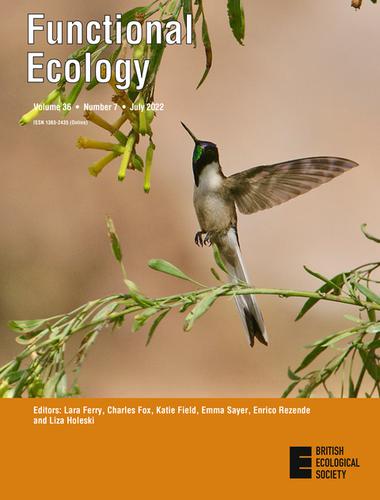当前位置:
X-MOL 学术
›
Funct. Ecol.
›
论文详情
Our official English website, www.x-mol.net, welcomes your
feedback! (Note: you will need to create a separate account there.)
Cover Picture and Issue Information
Functional Ecology ( IF 4.6 ) Pub Date : 2022-07-04 , DOI: 10.1111/1365-2435.13840
Functional Ecology ( IF 4.6 ) Pub Date : 2022-07-04 , DOI: 10.1111/1365-2435.13840

|
Strikingly elongated wings are often indicative of long-distance dispersal or migration in birds. However, they also occur in highly sedentary species with aerial lifestyles, such as the Bearded Mountaineer (Oreonympha nobilis) – pictured here foraging around flowers of tree tobacco (Nicotiana glauca) in the Peruvian Andes. Weeks et al. 2022 (doi: 10.1111/1365-2435.14056) compiled a global dataset of direct estimates of natal dispersal distances (i.e. distances moved by young animals from their place of birth) for birds that includes 114 species occurring in both temperate and tropical regions, from every continent in the world—except Antarctica. Using these data, they test whether species with higher hand-wing indices (i.e. species with wings that are more elongated, and thus are predicted to result in more efficient flight) have longer dispersal distances. They find that hand-wing index is a good predictor of dispersal distance while controlling for a range of ecological attributes of these species. Weeks et al. also characterize the degree to which species rely on flight in their daily routines (e.g. for foraging or commuting to roosting sites), and find that flight efficiency also predicts where species fall on this aerial lifestyle index. Taken together, these results suggest that a morphological determinant of flight efficiency that has been measured on all birds is a reliable predictor of dispersal distances. Additionally, flight efficiency is closely associated with the degree to which species rely on an aerial lifestyle. Dispersal is a fundamental ecological and evolutionary process, influencing everything from survival to large-scale evolutionary processes and these results suggest lower energetic constraints are correlated with greater use of flight, and ultimately longer dispersal distances (Photo Credit: Joe Tobias).
中文翻译:

封面图片及发行信息
惊人地拉长的翅膀通常预示着鸟类的远距离散布或迁徙。然而,它们也出现在具有空中生活方式的高度久坐的物种中,例如有胡子的登山者 ( Oreonympha nobilis ) - 如图所示,它们在树烟草 ( Nicotiana glauca ) 的花朵周围觅食) 在秘鲁安第斯山脉。周等。2022 (doi: 10.1111/1365-2435.14056) 编制了一个全球数据集,直接估计鸟类的出生扩散距离(即幼小动物从出生地移动的距离),其中包括温带和热带地区的 114 种鸟类,来自每个世界上的大陆——南极洲除外。使用这些数据,他们测试了具有较高手翼指数的物种(即具有更细长的翅膀的物种,因此预计会导致更有效的飞行)是否具有更长的分散距离。他们发现手翼指数是一个很好的扩散距离预测指标,同时控制了这些物种的一系列生态属性。周等。还描述了物种在日常生活中依赖飞行的程度(例如 觅食或通勤到栖息地),并发现飞行效率也可以预测物种在这个空中生活方式指数上的位置。总之,这些结果表明,在所有鸟类身上测量的飞行效率的形态决定因素是扩散距离的可靠预测指标。此外,飞行效率与物种依赖空中生活方式的程度密切相关。分散是一个基本的生态和进化过程,影响从生存到大规模进化过程的一切,这些结果表明,较低的能量限制与更多的飞行使用相关,最终更长的分散距离(照片来源:Joe Tobias)。这些结果表明,在所有鸟类身上测量的飞行效率的形态决定因素是扩散距离的可靠预测指标。此外,飞行效率与物种依赖空中生活方式的程度密切相关。分散是一个基本的生态和进化过程,影响从生存到大规模进化过程的一切,这些结果表明,较低的能量限制与更多的飞行使用相关,最终更长的分散距离(照片来源:Joe Tobias)。这些结果表明,在所有鸟类身上测量的飞行效率的形态决定因素是扩散距离的可靠预测指标。此外,飞行效率与物种依赖空中生活方式的程度密切相关。分散是一个基本的生态和进化过程,影响从生存到大规模进化过程的一切,这些结果表明,较低的能量限制与更多的飞行使用相关,最终更长的分散距离(照片来源:Joe Tobias)。
更新日期:2022-07-05
中文翻译:

封面图片及发行信息
惊人地拉长的翅膀通常预示着鸟类的远距离散布或迁徙。然而,它们也出现在具有空中生活方式的高度久坐的物种中,例如有胡子的登山者 ( Oreonympha nobilis ) - 如图所示,它们在树烟草 ( Nicotiana glauca ) 的花朵周围觅食) 在秘鲁安第斯山脉。周等。2022 (doi: 10.1111/1365-2435.14056) 编制了一个全球数据集,直接估计鸟类的出生扩散距离(即幼小动物从出生地移动的距离),其中包括温带和热带地区的 114 种鸟类,来自每个世界上的大陆——南极洲除外。使用这些数据,他们测试了具有较高手翼指数的物种(即具有更细长的翅膀的物种,因此预计会导致更有效的飞行)是否具有更长的分散距离。他们发现手翼指数是一个很好的扩散距离预测指标,同时控制了这些物种的一系列生态属性。周等。还描述了物种在日常生活中依赖飞行的程度(例如 觅食或通勤到栖息地),并发现飞行效率也可以预测物种在这个空中生活方式指数上的位置。总之,这些结果表明,在所有鸟类身上测量的飞行效率的形态决定因素是扩散距离的可靠预测指标。此外,飞行效率与物种依赖空中生活方式的程度密切相关。分散是一个基本的生态和进化过程,影响从生存到大规模进化过程的一切,这些结果表明,较低的能量限制与更多的飞行使用相关,最终更长的分散距离(照片来源:Joe Tobias)。这些结果表明,在所有鸟类身上测量的飞行效率的形态决定因素是扩散距离的可靠预测指标。此外,飞行效率与物种依赖空中生活方式的程度密切相关。分散是一个基本的生态和进化过程,影响从生存到大规模进化过程的一切,这些结果表明,较低的能量限制与更多的飞行使用相关,最终更长的分散距离(照片来源:Joe Tobias)。这些结果表明,在所有鸟类身上测量的飞行效率的形态决定因素是扩散距离的可靠预测指标。此外,飞行效率与物种依赖空中生活方式的程度密切相关。分散是一个基本的生态和进化过程,影响从生存到大规模进化过程的一切,这些结果表明,较低的能量限制与更多的飞行使用相关,最终更长的分散距离(照片来源:Joe Tobias)。











































 京公网安备 11010802027423号
京公网安备 11010802027423号